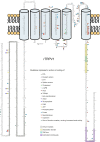Functionally important amino acid residues in the transient receptor potential vanilloid 1 (TRPV1) ion channel--an overview of the current mutational data
- PMID: 23800232
- PMCID: PMC3707783
- DOI: 10.1186/1744-8069-9-30
Functionally important amino acid residues in the transient receptor potential vanilloid 1 (TRPV1) ion channel--an overview of the current mutational data
Abstract
This review aims to create an overview of the currently available results of site-directed mutagenesis studies on transient receptor potential vanilloid type 1 (TRPV1) receptor. Systematization of the vast number of data on the functionally important amino acid mutations of TRPV1 may provide a clearer picture of this field, and may promote a better understanding of the relationship between the structure and function of TRPV1. The review summarizes information on 112 unique mutated sites along the TRPV1, exchanged to multiple different residues in many cases. These mutations influence the effect or binding of different agonists, antagonists, and channel blockers, alter the responsiveness to heat, acid, and voltage dependence, affect the channel pore characteristics, and influence the regulation of the receptor function by phosphorylation, glycosylation, calmodulin, PIP2, ATP, and lipid binding. The main goal of this paper is to publish the above mentioned data in a form that facilitates in silico molecular modelling of the receptor by promoting easier establishment of boundary conditions. The better understanding of the structure-function relationship of TRPV1 may promote discovery of new, promising, more effective and safe drugs for treatment of neurogenic inflammation and pain-related diseases and may offer new opportunities for therapeutic interventions.
Figures

Similar articles
-
Ca(2+) binding protein S100A1 competes with calmodulin and PIP2 for binding site on the C-terminus of the TPRV1 receptor.ACS Chem Neurosci. 2015 Mar 18;6(3):386-92. doi: 10.1021/cn500250r. Epub 2014 Dec 31. ACS Chem Neurosci. 2015. PMID: 25543978
-
Conserved residues within the putative S4-S5 region serve distinct functions among thermosensitive vanilloid transient receptor potential (TRPV) channels.J Biol Chem. 2010 Dec 31;285(53):41455-62. doi: 10.1074/jbc.M110.145466. Epub 2010 Nov 2. J Biol Chem. 2010. PMID: 21044960 Free PMC article.
-
Conserved allosteric pathways for activation of TRPV3 revealed through engineering vanilloid-sensitivity.Elife. 2019 Jan 15;8:e42756. doi: 10.7554/eLife.42756. Elife. 2019. PMID: 30644819 Free PMC article.
-
TRPV1: Structure, Endogenous Agonists, and Mechanisms.Int J Mol Sci. 2020 May 12;21(10):3421. doi: 10.3390/ijms21103421. Int J Mol Sci. 2020. PMID: 32408609 Free PMC article. Review.
-
TRPV1.Handb Exp Pharmacol. 2014;222:207-45. doi: 10.1007/978-3-642-54215-2_9. Handb Exp Pharmacol. 2014. PMID: 24756708 Review.
Cited by
-
A molecular perspective on identifying TRPV1 thermosensitive regions and disentangling polymodal activation.Temperature (Austin). 2021 Oct 26;10(1):67-101. doi: 10.1080/23328940.2021.1983354. eCollection 2023. Temperature (Austin). 2021. PMID: 37187836 Free PMC article. Review.
-
Beyond Neuronal Heat Sensing: Diversity of TRPV1 Heat-Capsaicin Receptor-Channel Functions.Front Cell Neurosci. 2021 Feb 5;14:612480. doi: 10.3389/fncel.2020.612480. eCollection 2020. Front Cell Neurosci. 2021. PMID: 33613196 Free PMC article. Review.
-
Endogenous and Exogenous Vanilloids Evoke Disparate TRPV1 Activation to Produce Distinct Neuronal Responses.Front Pharmacol. 2020 Jun 12;11:903. doi: 10.3389/fphar.2020.00903. eCollection 2020. Front Pharmacol. 2020. PMID: 32595512 Free PMC article.
-
A structural view of ligand-dependent activation in thermoTRP channels.Front Physiol. 2014 May 5;5:171. doi: 10.3389/fphys.2014.00171. eCollection 2014. Front Physiol. 2014. PMID: 24847275 Free PMC article. Review.
-
Combination of a Rapidly Penetrating Agonist and a Slowly Penetrating Antagonist Affords Agonist Action of Limited Duration at the Cellular Level.Biomol Ther (Seoul). 2019 Sep 1;27(5):435-441. doi: 10.4062/biomolther.2019.013. Biomol Ther (Seoul). 2019. PMID: 31302951 Free PMC article.
References
Publication types
MeSH terms
Substances
LinkOut - more resources
Full Text Sources
Other Literature Sources

